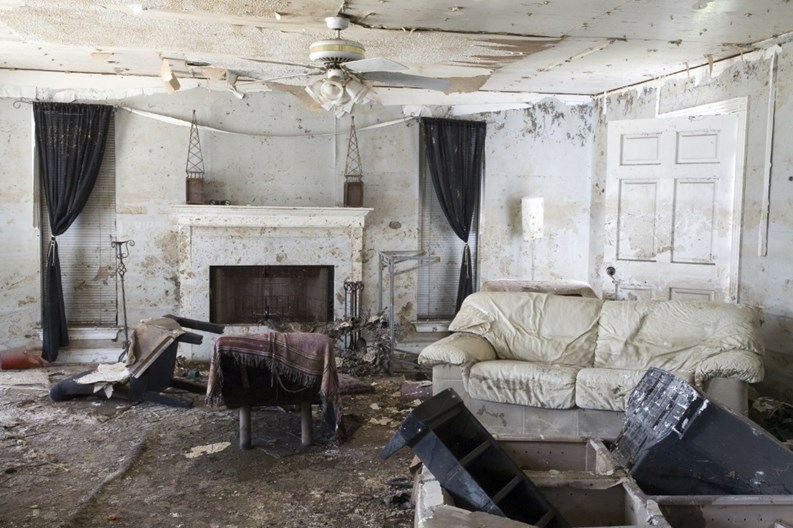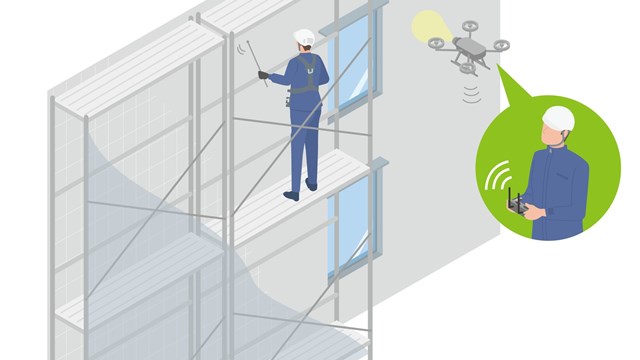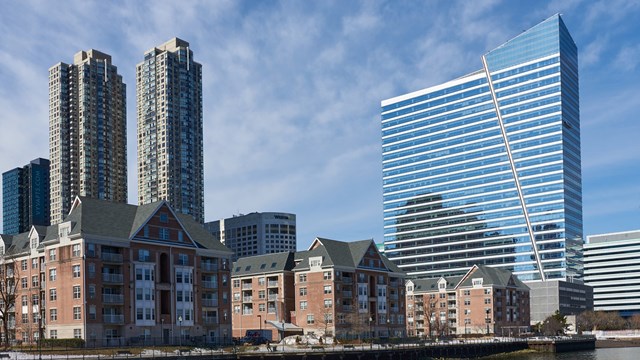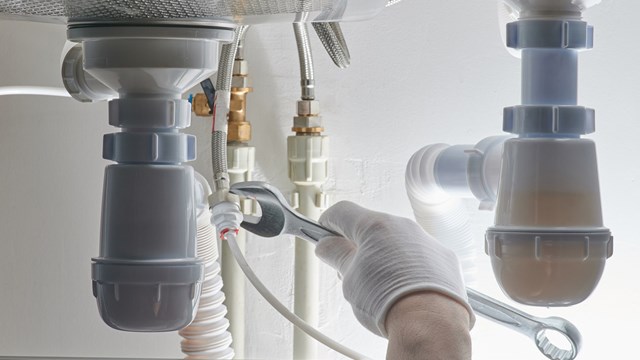Water is vital to sustaining life, but keeping it in its place is vital to the sanity—and bank accounts—of both boards and residents of HOAs.
Infiltration of H2O into an apartment or other parts of a building can throw people into a panic, cause peeling paint and damage walls, floors and carpeting. If left unattended long enough, water leaks can also lead to mildew and mold—and possible health hazards down the road.
Leaks are not only extremely destructive, but they're also notoriously difficult to locate. But good waterproofing contractors know how to find and repair leaks before their effects get serious. Waterproofing, in essence, means preventing water from infiltrating openings near a building's roof, exterior siding, windows, doors, balconies, parking garages—any vulnerable area. As with so many other building issues, keep your HOA free of leaks is a matter of staying on top of things and reacting quickly to early signs of trouble.
Preventive Measures
Mike Keller, of George J. Keller and Sons LLC, in Flanders, which specializes in roofing and siding, says the best way to keep water out is through regular inspections.
"One thing I would suggest is to have either a maintenance contract or a biannual inspection, depending on the age of the roof and siding, and to have it inspected by a qualified firm that can look at outdoor areas," Keller says. "Have them look at the roof, look at the siding, the connections between the siding and the windows, the siding and the doors. They should make sure there's no water infiltration and that there's no caulking that needs to be updated on the siding." Contractors should also make sure shingles haven't been blown off, check for nails that are coming loose, and inspect areas surrounding pipes to be sure they're properly sealed.
Every building, of course, is different, but Keller says inspecting a roof, siding and exterior for the average building will take about two to three hours, with the cost ranging from $250 and $600. The inspection will include a written report and estimate for repair costs.
Where's the Leak?
Let's say an apartment in your building has water dripping through the living room ceiling. Obviously there's a leak directly above it, in the building's roof or beneath the floor of the unit above it, right?
Wrong. One of the things that makes water infiltration so tricky is that the cause of a leak may not be anywhere near the location where water is actually invading the building.
"Generally speaking, the source of any type of leak isn't where it infiltrates the interior of the building, it's generally in a different spot," Keller says. "Water takes the path of least resistance, so a lot of times, water will enter the condo at a certain point, then run down a rafter or a beam. Then it might hit a nail on a beam, or a knot in the wood that it can't pass, then gravity gets hold of it and takes it down, so that's where you see it actually entering the building."
Certain areas of a building are more prone to leaks than others.
"Any penetration in the roof [can be a source of leaks]" Keller says. "So if you have a pipe coming through or a power fan or a skylight or something like that, and if you have a leak in a room that's below one of those items, generally you can say that's where the water is coming from."
Jim Murphy, owner of Pro-Tec Building Restoration Services in East Hanover says it's common for the location of the leak to be "far removed" from its source.
"We've had situations where a guy's getting a leak on the second floor," Murphy says. "So we go and check the second-floor windows and we check the façade and everything seems OK. Then we go to the fourth floor and that's where the problem is, and there's nothing happening on the third floor."
One method Murphy uses to determine the sources of leaks is flood testing. This involves using a controlled source of water that simulates a rain storm.
"Let's say you're a tenant of the building and you're on the 15th floor, and every time there's a blowing rainstorm from the east, you get water in your apartment," Murphy says. "The first thing we'll do is take a cursory look to see if there's anything obvious and address that."
If that doesn't work your waterproofer may take a spray bar with multiple nozzles and start spraying areas of the building with it. When an employee who's inside the building sees a leak, he'll contact the crew via a handheld radio. It can be a costly process, but it positively identifies the problem.
"And that puts the onus on me," Murphy says. "I'm the expert who came to your building and said, 'I found the problem, I know what it is and how to fix it.' If there's another leak, I pretty much have to go back on my own dime."
On the Side
According to Keller, leaks in siding can be tricky because water will penetrate the wall but won't be visible on the interior.
"You can have situations where your siding is leaking and letting water in, so you won't know that until the sheeting is rotted or the insulation is damaged and you end up with holes in the wall or siding is falling off," he says.
But through regular inspections, a professional can identify situations before they become serious.
It's definitely [in a building's] best interests to have inspections done, to pay attention to things," Keller says. "They should listen to their membership, if homeowners are saying, 'I've got a problem here,' don't just pass it off as someone being a pain. Investigate this stuff."
One important reason to stay on top of leaks is the threat of mold. Keller points out that concerns about mold and mildew can be blown out of proportion, and that mold doesn't form overnight, but if left alone it can become an issue.
How the Damage is Done
Leaks form in buildings for various reasons. Keller cites poor construction and inferior products as possible causes. Some perishable items, like caulking, may need to be changed on occasion because of weather and wood trim used on exteriors may deteriorate. New products like composite woods help waterproof exteriors as does capping trimmings with aluminum.
If you're running, or living in, a new building, don't think that means you're living leak-free. According to Murphy, details can get overlooked during construction because of a lack of communication between contractors. For example, the perimeter of a window may not get caulked because the window contractor thinks that's the masonry contractor's job, and vice versa.
"The responsibilities get jumbled up and they don't communicate," says Murphy. "And a lot of times these little details, which are crucial to the building envelope performing properly, aren't done correctly. That tends to lead to a lot of problems."
Keller says non-professionals would be surprised if they knew how many new buildings develop leaks. For example, one resident he knows of in a five-year-old commercial building has had leaks almost from Day One. As a result, the resident is suspicious toward contractors.
"I look at it and I say, 'This is a mess,'" Keller says. "So I make recommendations on how to fix it. A lot of times my position has to be, 'This is what needs to be done, and if you want me to stand behind it afterwards, this is the way we have to do it so that it's done properly.' There are only so many things you can Band-Aid and patch."
And, of course, precautions have to be taken over the course of a building's life.
"If you're not proactive with these buildings and you just respond to problems and have a 'If it ain't broke, don't fix it' type of attitude that leads to more problems," Murphy says. "You have to be proactive and have yearly inspections and have a program to keep on top of this stuff. Little problems can be corrected before they become big problems."
Communication between residents and building management is another key. Murphy explains that sometimes tenants may not contact management until a problem gets serious. Then the building's maintenance will do a repair without being really familiar with the building's envelope or realizing the leak has been around longer than they think.
"They'll caulk something that shouldn't be caulked, which in turn can trap water behind certain egress systems," Murphy says. When asked, he adds that about 90 percent of the calls he gets are reactions to problems that might have been prevented (or stopped earlier) with inspections or if he had been called sooner.
Bricks, Balconies and Parking Garages
Murphy says brick facades pose problems with open joints, which can lead to water infiltrating the building. When that happens, he says several "courses" (or rows) of bricks above the lintels will be removed so that waterproofing materials can be put in and perhaps have "weep holes" (small holes in the outer wall that allows water to drain) installed.
"That's a worst-case scenario if there's nothing that can be done on the exterior to fix the problem," says Murphy. "If it's determined that the water is getting through the building's skin some way, and the problem is behind the skin, whether the building is clad in brick or stucco or whatever, the next step is to go behind the wall and do some work back there."
Concrete balconies are another troublesome area, where water damage can lead to pieces of concrete falling off, which obviously poses a danger.
"What sometimes happens is the re-enforcing rods in the concrete of the balconies start to rust because of water infiltration, says Chuck Colacurcio, vice president of Eastern Waterproofing and Restoration in Jersey City. And that causes pieces of the concrete to break off the surface and fall. That's dangerous, so we do a lot of jobs where we replace those.
Buildings with parking garages have an additional concern. According to Colacurcio, ice and water falling off cars (along with salt used to melt ice in the garage) can cause damage to garage floors.
"The water and ice freeze-thaws and causes the concrete floor to deteriorate," Colacurcio says. "That's a major expense to these buildings because they've never maintained their garages, and all of a sudden they're looking at taking out the entire floor of their parking garages, or long sections of them, and we have to break it up, put new steel in and replace the concrete." He adds that this can be prevented through the application of a urethane or breathable waterproofing material.
Again, it all comes down to prevention. "The idea is to look around and pay attention to things," Keller says. "Be cognizant of your building and complex and realize that a lot of times you're better off being proactive, you can save yourself and your association money in the long term."
Anthony Stoeckert is a freelance writer and a frequent contributor to the New Jersey Cooperator.







Leave a Comment